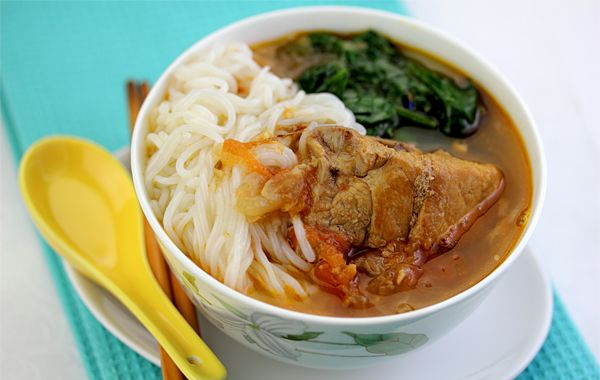Canh bún is a simplified version of bún riêu. It has a similar, red-colored sweet broth except it doesn’t contain tomatoes. The soup is also softer in texture; round, thick noodles are used and fried tofu pieces and rau muong (pea shoot tendrils) are added at the last minute.
Traditionally, pork is used for canh bun but I prefer cooking with veal instead. You could stick to the more authentic version or use other meat and add riêu (crab morsels) as well.
1. Info for Canh Bun Recipe (Vietnamese Soup)
- Cook Time: 1 hr 20 mins
- Total Time: 1 hr 50 mins
- Servings: 8
- Calories: 230Kcal
2. Ingredients for Canh Bun Recipe (Vietnamese Soup)
- 8 cups Vietnamese chicken broth
- 3 pounds veal meat and bones
- 2 tablespoons canola oil (or any neutral oil)
- 1 carrot, cut in half
- 1 daikon, cut into thirds
- 2 teaspoons freshly grated palm sugar
- 1 clove garlic, crushed and finely minced
- 1 teaspoon paprika
- 1 teaspoon annatto seeds (see tips)
- 1½ teaspoons mushroom seasoning salt (or regulat salt)
- 1½ pounds rau muong (Vietnamese pea shoot tendrils)
- 3 green onions, sliced
- 3 tablespoons chopped cilantro
- 1 cup combined Vietnamese herbs
- 3 cups deep-fried tofu, cut into large cubes
- 1 teaspoon black pepper, freshly ground
- juice of 1 lime
- 2 packages round rice noodles (preferably the thick ones), soaked for 1 hour, then boiled
- 1 lime, freshly squeezed + extra for garnish
3. Directions:
- Prepping the pea shoot tendrils: Wash the pea shoots thoroughly in several baths. The greens tend to be very sandy, so wash them carefully. Remove and discard any older, fibrous parts of the stems. Drain as much water as possible. Cut the stems into 4-inch sections.
- Blanching the pea shoot tendrils: (You could skip this step but my uncle prefers it this way). Blanch the rau muong in about a quart of salted boiling water. Cook for about 1 minute. Drain and immediately transfer the greens into a cold water bath. Pat dry on towels. Remove as much liquid as possible. Season with salt.
- Cooking the meat and bones:
- Rinse the meat.
- This step is important to get clear broth before starting the long, slow cooking. Fill a 12-quart stockpot with about 6 quarts of water (enough to cover the bones). Bring to a boil. Add the whole pieces of meat and bones. Bring the liquid back to a gentle boil, then lower the heat to a bubbly simmer and cook for 3 minutes. Skim the impurities rising to the surface of the broth using a fine mesh strainer and set the veal, the bones and 4 quarts of strained liquid aside.
- In a stockpot, place the meat, bones, peeled onion, 4 quarts of the strained reserved liquid, carrot, daikon and complete with chicken broth until everything is submerged in liquid. Cover and let simmer for 90 minutes.
- Completing the broth:
- Into a pan, add the oil. Add garlic, paprika and the annatto seeds. Dissolve a little warm broth into the mixture, bring to a boil; using a strainer, immediately transfer back to the stockpot, discarding the seeds.
- Check the seasoning. Adjust sweetness of the broth. Season with more salt and pepper if necessary. The secret is to balance the sweetness then the saltiness. Be sure not to over-salt!
- Assembly time (when you’re ready to serve):
- Bring the soup back to a boil. Let simmer for about 10 minutes to make sure it’s warm enough. Add 2 tablespoons green onions. Cover for 5-8 minutes, then remove the pot from the stove. Let sit until you’re ready to serve. Add the rau muong and deep-fried tofu and slowly drizzle with lime juice.
- Line up your serving bowls. Place some green onions and Vietnamese herbs in each bowl. Add the fried tofu and boiled rice noodles. Ladle the broth into the bowls with the pieces of veal meat. Top with rau muong.
- Fill the bowls with more broth.
- Serve with nuoc cham, lime wedges and fresh chiles on the side.
- Serve immediately.
- Sprinkle with black pepper. Drizzle some nuoc mam into the broth to finish.
- Bon appétit!
4. Tips and advices:
- Make sure to choose young, bright green rau muong leaves so they are quite tender, especially the leaves.
- You can find rock sugar in any Asian stores. You can also use granulated sugar.
- Annatto seeds can be found in any Asian stores. They’re called hot dieu in Vietnamese and help provide a pretty reddish color to the broth.
- I didn’t have the right kind, but the thicker the noodles the better. Look for bún tam bì, if possible.
- Mushroom seasoning salt brings a very distinct, earthy flavor to the sauce. You can find it at gourmet specialty stores or in most Korean stores.

